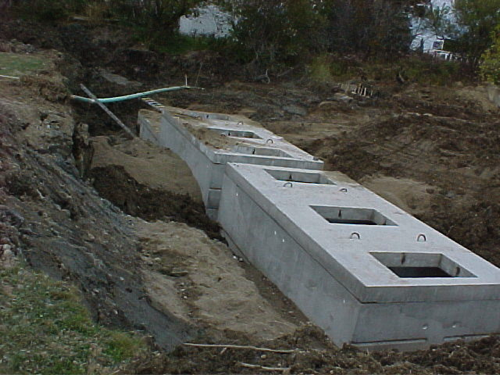 Strategies for Rural Development in Areas with Limited Public Infrastructure: Alternative Septic Systems
Strategies for Rural Development in Areas with Limited Public Infrastructure: Alternative Septic Systems
Onsite Pre-Treatment: Milbridge, Maine
The Town of Milbridge was facing a major wastewater disposal problem. This small coastal town has a public sewer system serving its village area, to which all local residents and businesses are connected. For many years, Milbridge operated its small wastewater treatment plant under a 301(h) waiver from the most stringent requirements for its National Pollutant Discharge Elimination System (NPDES) permit. The waiver allowed Milbridge to continue to discharge wastewater into Narraguagus Bay following primary treatment at the plant, despite organic and suspended solids contents in the treated effluent that often exceeded federal water quality minimum standards. The rationale for the waiver was that the dilution and constant wave action of ocean water would take care of any remaining water quality issues in the wastewater discharge, so it did not make sense for the federal regulators to force a small town like Milbridge to retrofit its plant with costly secondary treatment systems. In 2008, however, the Environmental Protection Agency informed Milbridge officials that the town’s 301(h) waiver would be disallowed when its NPDES license renewal came up in 2010, because the bay had been reclassified as a stressed estuary.
The primary sources of high organic and suspended solids loading are two restaurants and a nursing home. Most other public sewer users are either residential customers or small commercial operations. The nursing home, Narraguagus Bay Health Care, discharges approximately 700 gallons per day. The restaurants each generate flows of approximately 600 gallons per day, including nightly cleaning of their grease traps. Several secondary treatment alternatives and add-on processes were considered for the wastewater treatment plant, including the use of ultraviolet light for disinfection and open treatment lagoons to remove nutrients. All were deemed too expensive both in initial capital outlay and in future operational and maintenance costs for the town. After careful consideration of all feasible alternatives and the town’s limited fiscal resources, the town’s engineering consultant recommended the use of proprietary onsite pre-treatment technology at each of the commercial facilities.
Milbridge Town Manager Lewis Pinkham was able to secure a $500,000 Public Infrastructure grant through the Community Development Block Grant program to help Milbridge fund their pre-treatment system:
( 5 min 28 sec Video)
Pre-treatment tanks during installation (Photo: Lewis Pinkham)

The studies concluded that with this preliminary onsite treatment, the effluent from each of the commercial facilities could be released into the public sewer system, pre-treatment would significantly reduce both suspended solids and heavy organic loading in the commercial wastes, and produce an effluent with a negligible (possibly a beneficial) effect when combined with wastewater from the town’s other generators in the sewer main. The town was able to secure $500,000 through a Community Development Block Grant plus $125,000 in supplementary funding from the Clean Water State Revolving Fund to install the new equipment. This consisted of a large septic tank followed by two to three pre-treatment tanks in series for each facility, each containing three proprietary biological filtering units (resembling giant honeycombs).
Engineering design for the project was completed in 2009, and installation of the new subsurface treatment equipment at all three sites was completed in 2010. The pre-treatment tanks and associated pumps are equipped with remote monitoring and control technology, so any malfunctions can be addressed by the system operator before they start to create problems. Grant funds also paid for a new building to augment the existing disinfection facility at the treatment plant, so that laboratory testing, remote system monitoring, and office business can now be conducted in a clean, quiet environment. The Town Manager states that the commercial effluent emerging from the pre-treatment tanks was almost as clean as drinking water, and it had actually improved the testing results at the treatment plant since it had a diluting effect on the rest of the wastewater stream. The Milbridge Wastewater Treatment Plant received its NPDES license renewal and passed its 2011 EPA inspection with flying colors, meeting all water quality standards for surface water discharge.
The town is also considering construction of onsite septic systems with aeration pre-treatment technology to permit subsurface wastewater treatment and disposal for several multiple-unit residential complexes in Milbridge.
For more information: Lewis Pinkham, Town Manager, 546-2422 or milbridgetown@yahoo.com
Milbridge Town Manager Lewis Pinkham provides a tour of three pre-treatment systems:
( 3 min 37 sec Video)
Related Work Plan Components
- Climate Change and Infrastructure Resilience
- Modernizing Communications/Electric Utility Infrastructure
Workgroup Contacts
In Aroostook County: Jay Kamm, Ken Murchison, Joella Theriault
In Washington County: Judy East

Share this content: